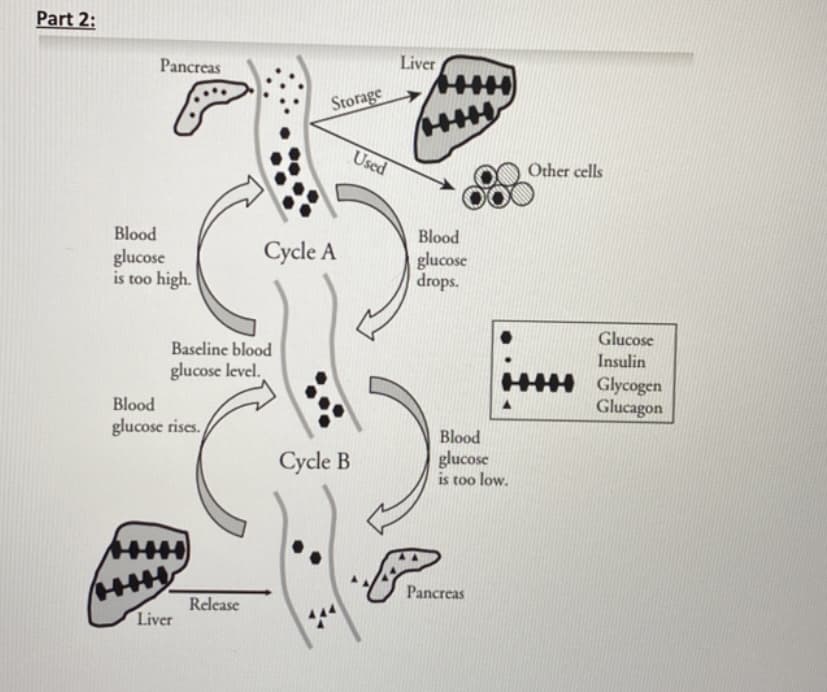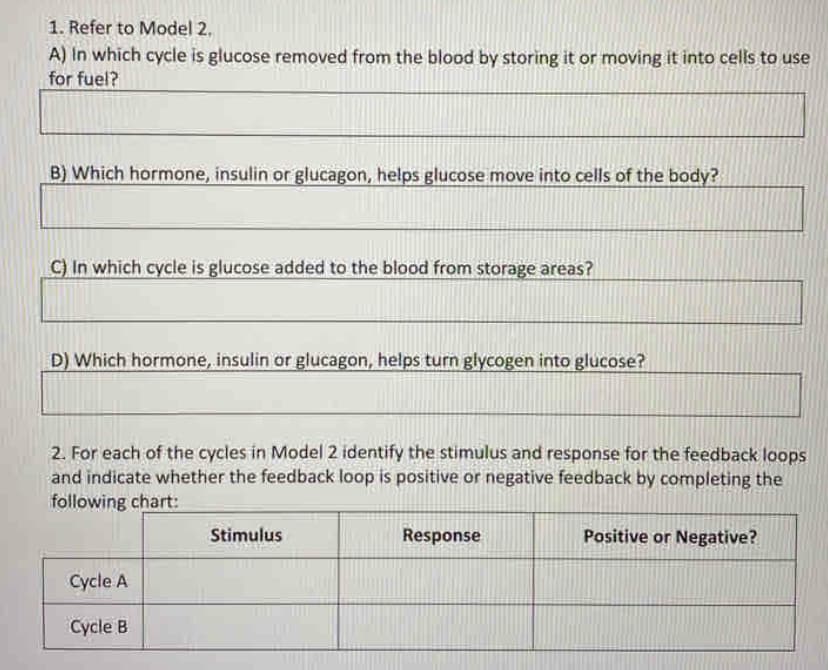1. Refer to Model 2, A) in which cycle is glucose removed from the blood by storing it or moving it into cells to use for fuel? MERE B) Which hormone, insulin or glucagon, helps glucose move into cells of the body? C) In which cycle is glucose added to the blood from storage areas? D) Which hormone insulin or glucagon helps turn glycogen inte glucose?
1. Refer to Model 2, A) in which cycle is glucose removed from the blood by storing it or moving it into cells to use for fuel? MERE B) Which hormone, insulin or glucagon, helps glucose move into cells of the body? C) In which cycle is glucose added to the blood from storage areas? D) Which hormone insulin or glucagon helps turn glycogen inte glucose?
Anatomy & Physiology
1st Edition
ISBN:9781938168130
Author:Kelly A. Young, James A. Wise, Peter DeSaix, Dean H. Kruse, Brandon Poe, Eddie Johnson, Jody E. Johnson, Oksana Korol, J. Gordon Betts, Mark Womble
Publisher:Kelly A. Young, James A. Wise, Peter DeSaix, Dean H. Kruse, Brandon Poe, Eddie Johnson, Jody E. Johnson, Oksana Korol, J. Gordon Betts, Mark Womble
Chapter23: The Digestive System
Section: Chapter Questions
Problem 18RQ: Which phase of deglutition involves contraction of the longitudinal muscle layer of the muscularis?...
Related questions
Question
Please look at the diagram to be able to solve the question the diagram is not a question. Thanks

Transcribed Image Text:Part 2:
Pancreas
Blood
glucose
is too high.
Blood
glucose rises.
Liver
Baseline blood
glucose level.
Release
Storage
Cycle A
Cycle B
Used
Liver
F
Blood
glucose
drops.
Blood
glucose
is too low.
Pancreas
Other cells
Glucose
Insulin
Glycogen
Glucagon

Transcribed Image Text:1. Refer to Model 2,
A) in which cycle is glucose removed from the blood by storing it or moving it into cells to use
for fuel?
B) Which hormone, insulin or glucagon, helps glucose move into cells of the body?
C) In which cycle is glucose added to the blood from storage areas?
D) Which hormone, insulin or glucagon, helps turn glycogen into glucose?
2. For each of the cycles in Model 2 identify the stimulus and response for the feedback loops
and indicate whether the feedback loop is positive or negative feedback by completing the
following chart:
Stimulus
Response
Positive or Negative?
Cycle A
Cycle B
Expert Solution
This question has been solved!
Explore an expertly crafted, step-by-step solution for a thorough understanding of key concepts.
This is a popular solution!
Trending now
This is a popular solution!
Step by step
Solved in 2 steps

Knowledge Booster
Learn more about
Need a deep-dive on the concept behind this application? Look no further. Learn more about this topic, biology and related others by exploring similar questions and additional content below.Recommended textbooks for you

Anatomy & Physiology
Biology
ISBN:
9781938168130
Author:
Kelly A. Young, James A. Wise, Peter DeSaix, Dean H. Kruse, Brandon Poe, Eddie Johnson, Jody E. Johnson, Oksana Korol, J. Gordon Betts, Mark Womble
Publisher:
OpenStax College

Health Safety And Nutrition F/Young Child
Health & Nutrition
ISBN:
9781305144767
Author:
MAROTZ
Publisher:
Cengage


Anatomy & Physiology
Biology
ISBN:
9781938168130
Author:
Kelly A. Young, James A. Wise, Peter DeSaix, Dean H. Kruse, Brandon Poe, Eddie Johnson, Jody E. Johnson, Oksana Korol, J. Gordon Betts, Mark Womble
Publisher:
OpenStax College

Health Safety And Nutrition F/Young Child
Health & Nutrition
ISBN:
9781305144767
Author:
MAROTZ
Publisher:
Cengage


Biology 2e
Biology
ISBN:
9781947172517
Author:
Matthew Douglas, Jung Choi, Mary Ann Clark
Publisher:
OpenStax

Fundamentals of Sectional Anatomy: An Imaging App…
Biology
ISBN:
9781133960867
Author:
Denise L. Lazo
Publisher:
Cengage Learning
